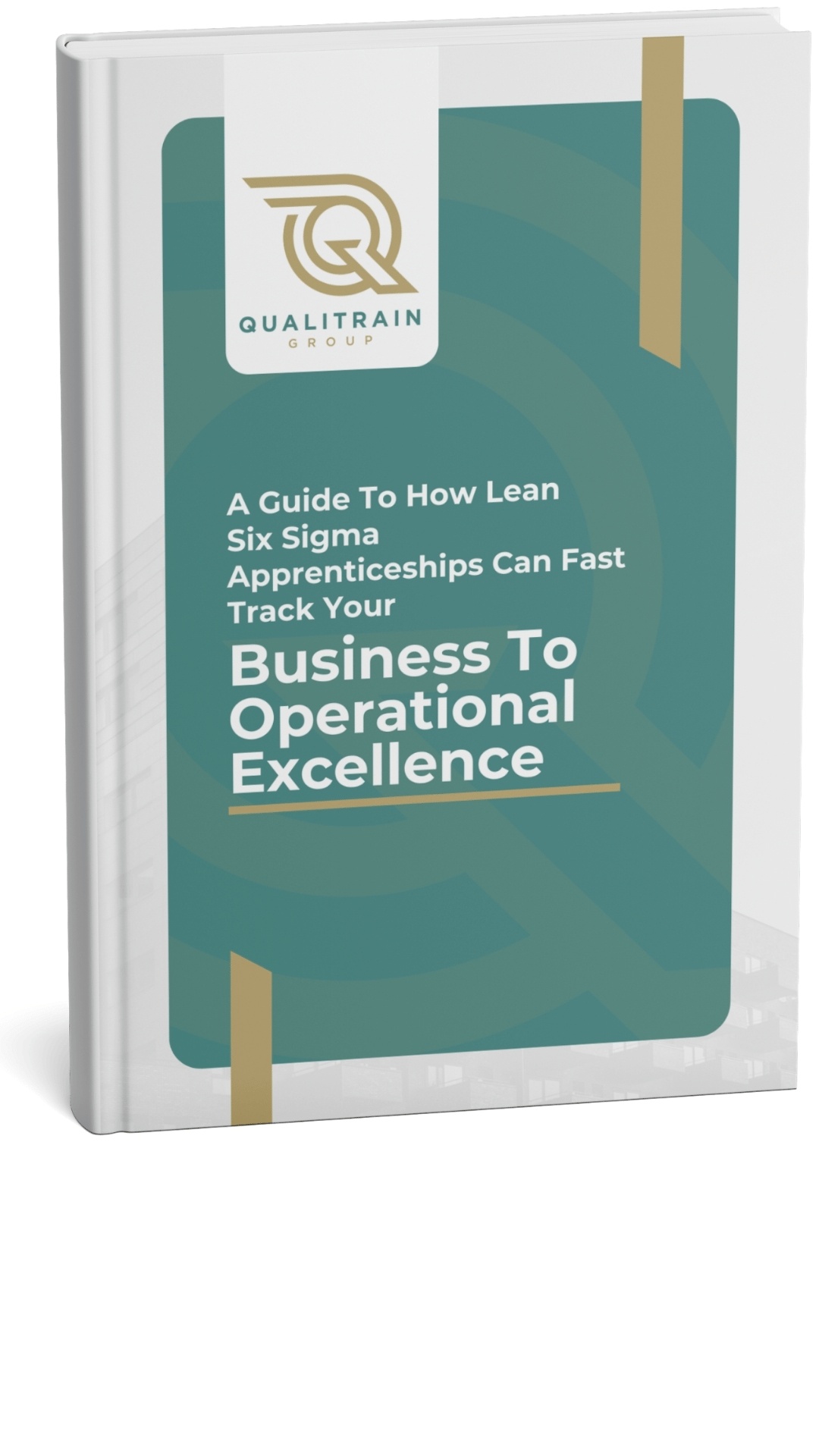Business To Operational Excellence
A Guide To How Lean Six Sigma Apprenticeships Can Fast Track Your
Introduction
Operational excellence is an approach to business that focuses on continuous improvement. It aims to increase operational efficiency, reduce waste and costs, enhance quality, and boost customer satisfaction. Essentially, operational excellence means optimising business processes and systems in order to achieve ever-better results.
Being able to adapt and compete in today’s fast-paced market gives ambitious businesses a real advantage. In fact, gaining this edge is so important that operational excellence is no longer a luxury, it’s a necessity. Successfully putting the philosophy into action allows businesses to deliver products and services on time and on budget to a consistently high standard, something that’s essential for growth, customer satisfaction and profitability.

A core part of operational excellence is continuous improvement. Fostering a culture of continuous improvement encourages employees to identify inefficiencies, implement solutions and strive for better results. This pursuit of ongoing improvement ensures your business is able to remain competitive and adaptable long term.
Operational excellence addresses some of the main challenges faced by businesses today. Namely cost overruns, schedule delays and quality variations. These issues are also at the heart of Lean Six Sigma. Designed to help businesses adapt, improve and compete, Lean Six Sigma could be your path to operational success.
What Is Lean Six Sigma?
Lean Six Sigma is a powerful methodology that combines Lean principles with Six Sigma techniques. Implementing the strategy can help businesses cut waste, improve quality, enhance teamwork and boost adaptability. The core principles of the philosophy include:
Combating Waste
Reducing waste (aka non-value adding work) – there are 7 forms of waste that delay the flow of value through your business processes. This waste extends your lead time, costs money and frustrates your stakeholders. Lean thinking focuses on the reduction of these wastes in order to achieve flow and meet the demand of your customers. The 7 wastes are as follows:
- Transportation - the unnecessary movement of materials or information.
- Inventory - high levels of stock or work in progress that tie up working capital, extend lead times for customer orders and impact cash flow.
- Motion - the unnecessary movement of people when locating the things they need to do their job.
- Waiting - the customer order stands idle waiting to be worked on.
- Over production - processing or making more than the customer demand. Leads to high inventory levels.
- Over processing - doing work that the customer does not value, or has specified.
- Defects - poor quality work that has to be corrected or redone.
%20(1).webp?width=2132&height=1453&name=JDRGroup-Qualitrain%20-%20EbookGuide-1600x2400px-DD-AKM_10-Feb-25%20(1)%20(1).webp)

Want to improve efficiency and cut costs?
Learn how Lean Six Sigma apprenticeships can help your team deliver real results.
Here, you’ll find:
✅ What Lean Six Sigma Apprenticeships are and how they work.
✅ How they deliver faster, higher-quality results.
✅ Simple steps to get started.
Claim your free guide to see why our Students, on average save £142k per improvement project.
Minimising Defects
The Six Sigma methodology is data driven and focuses on the relentless reduction of variation in the process output by ensuring that process inputs are stable, controlled and within specification. The aim is to ensure that your process output variation is so small that the customer won’t even notice it.
Root Cause Analysis
Not only does Lean Six Sigma help businesses to identify problems in their processes, it also gives them tools to find and eliminate the root causes of these issues. Addressing these causes can prevent problems from reoccurring and help your business to succeed long term. Moving beyond containment action, (the sticking plaster approach) to implementing countermeasures is key to successfully addressing root causes.
Process Mapping
Process mapping allows organisations to visualise workflows and gain a clearer understanding of each step involved. This can help to identify bottlenecks and spot areas that could benefit from improvement.
Teamwork And Collaboration
If the implementation of Lean Six Sigma is going to be successful in your company, you’ll need the collaboration and cooperation of all of your team members. Getting all stakeholders onto the same page, and ensuring everyone is working towards the same goal, will enhance teamwork in your organisation and optimise your workforce.
Benefits of Lean Six Sigma
Successfully implementing Lean Six Sigma can benefit your business in a number of ways. Some of the most important advantages offered by the methodology include:
Improved Project Delivery
Streamlining your processes and creating more efficient workflows will contribute to improved project delivery. Being able to deliver projects on time and on budget will help the overall productivity and profitability of your business.
Enhanced Quality
Through data-driven analysis, variation reduction, and root cause identification, businesses can minimise errors and ensure projects consistently meet required specifications and standards. Enhancing the quality and consistency of your products or services is a powerful way to boost customer satisfaction.
Increased Efficiency
Eliminating non-value-added activities is one of the core Lean principles. Taking these activities out of the equation will benefit your business by optimising your use of resources and helping you maximise your manpower and materials.
Improved Customer Satisfaction
Customer satisfaction is an important aspect of operational excellence. Using Lean Six Sigma to deliver high quality projects on time and on budget will lead to improved customer satisfaction and more loyal clients.
Culture Of Continuous Improvement
The added value offered by a culture of continuous improvement should never be underestimated. Creating an environment where employees feel motivated to identify inefficiencies and seek improvements can help your business to continually evolve and offer customers an ever-better experience.
Competitive Advantage
The benefits offered by the Lean Six Sigma methodology equip firms with the tools and strategies required to achieve operational excellence and stay one step ahead of the competition.
Skills Development
These types of apprenticeships offer a number of important advantages over traditional training methods. For a start, they not only teach Lean Six Sigma tools, they also help participants to develop valuable transferable skills. From problem solving to data analysis, these specialist courses help new team members to gain the practical and theoretical skills required to contribute to an innovative and ambitious business.
Cost-Effective
Traditional training pathways can be expensive. Apprenticeships on the other hand often provide a return on investment for employers. During their training, apprentices work on, and contribute to, real projects. This allows them to learn in real world situations and reduces your need for additional resources.
Improved Learning
One of the most important benefits of an apprenticeship for trainees is that it gives them the opportunity to learn in a real-world environment. Engaging in the practical application of newly learned skills helps apprentices to retain the information that they’re taught. It can also foster a deeper understanding of processes and systems and ensure the apprentice has readily applicable skills when fully certified.
Talent Pipeline
Well-run apprenticeships help companies to build a talent pipeline. The trainees of today will be the Lean Six Sigma leaders of tomorrow, giving your organisation a workforce that’s skilled, efficient and innovative at every level.
Having a talent pipeline also ensures the long-term sustainability of your continuous improvement initiatives, something that can help to enhance the outcome of long-standing projects and keep your business on the Lean Six Sigma track.
Career Opportunities
Earning Lean Six Sigma certification through an apprenticeship is great for the participant’s future career opportunities. Completing a program demonstrates that the apprentice has a commitment to continuous learning. It also shows that they’re equipped with a number of practical skills that are invaluable in a modern workforce.
How Lean Six Sigma Apprenticeships Can Benefit Your Business
Having a team of new, enthusiastic apprentices armed with Lean Six Sigma training can provide a huge boost to business. Their ability to problem-solve, analyse data and improve processes can enhance operations at every level of your organisation.
.webp?width=2880&height=1919&name=JDRGroup-Qualitrain%20-%20EbookGuide-1600x2400px-DD-AKM_10-Feb-25%20(8).webp)
During a Lean Six Sigma apprenticeship, trainees will be taught the importance of data-driven analysis. They’ll learn to collect, interpret and utilise data in order to improve opportunities, measure progress and ensure the decisions they make are based on facts, not intuition.
Having employees that are capable of this type of critical thinking and analysis can help your business to optimise its resources, meet customer needs and improve processes.
As we’ve already seen, creating a culture of continuous improvement within an organisation can be incredibly beneficial. Investing in an apprenticeship program that has this concept built in will mean that continuous improvement is ingrained in your organisation’s DNA. As apprentices progress within the business, they’ll disseminate these ideas, inspire colleagues and keep your organisation moving forward.
Apprenticeship courses are great for employee engagement and motivation. Participating in real-world projects, and seeing their impact first hand, helps to keep trainees interested and builds their commitment to your organisation.
Apprenticeship programmes can also help you create a more loyal workforce. According to a recent study by the Skills Funding Agency, 80% of employers reported that their retention rates improved as a result of hiring apprentices. What’s more, 65% of apprentices stay working for the same company that trained them during their apprenticeship programme.
Qualitrain: Your Partner in Lean Six Sigma Success
Understanding the benefits of Lean Six Sigma apprenticeships, and providing programs that meet these unique standards, are two very different things. The best way to guarantee your business - and your apprentices - gain all of the benefits offered by the methodology is to work with an expert partner like Qualitrain.
With extensive experience providing Lean Six Sigma programs, Qualitrain can work with team members at all levels of your organisation. Our processes and principles can be applied to a wide range of businesses and industries, allowing your team to benefit from our skills and expertise no matter what your sector.
.webp?width=2880&height=1919&name=JDRGroup-Qualitrain%20-%20EbookGuide-1600x2400px-DD-AKM_10-Feb-25%20(9).webp)
Working with Qualitrain to offer high quality Lean Six Sigma apprenticeships can help your organisation to achieve operational excellence and gain all of the advantages offered by the business strategy. Our expert team can guide participants through their apprenticeships, helping your organisation to reach its Lean Six Sigma goals and giving apprentices training that will benefit them throughout their careers.
To learn more about Lean Six Sigma apprenticeships and the varied advantages they can offer your organisation, contact our specialist team today!
Our Accreditations & Awards








.webp?width=150&height=150&name=IPAF%20Member%20(1).webp)



.webp?width=3040&height=2026&name=JDRGroup-Qualitrain%20-%20EbookGuide-1600x2400px-DD-AKM_10-Feb-25%20(6).webp)